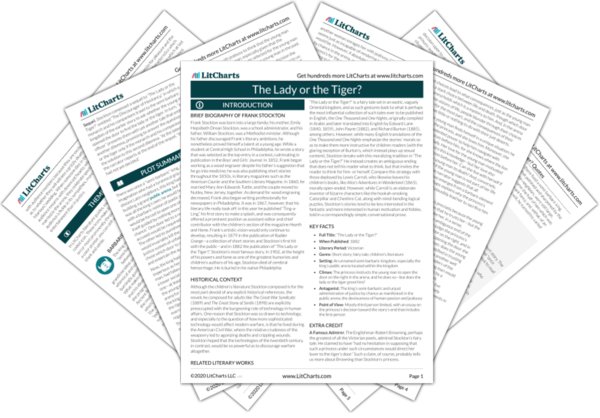Since the public arena doesn’t administer justice at all, really, we might wonder why the king instituted it in the first place, and why his subjects in the audience continue to tolerate it. The story suggests that both king and subject do so because they are pleased and entertained by what they witness in the arena, be it “a bloody slaughter or a hilarious wedding.” Both treat what happens in the arena as a work of art, a spectacular drama taut with suspense that evokes pity and terror if the accused opens the door to the tiger, or that evokes relief and laughter and merriment if the accused opens the door to the lady. In this sense, the audience of the trial in the story mirrors us as the story’s readers: we are watching a drama unfold that interests us and gives us pleasure, even as we squirm with anxiety wondering what the young man’s fate will be.
However, the story goes on to make a dark point: the audience at the arena becomes so pleased and entertained by what they witness that they seem to forget that down below on trial are not actors but real people filled with real dread, in an unjust and potentially deadly situation. When we treat life like art, it becomes all too easy to ignore human suffering and even to become complicit in it. What’s worse is that the audience recognizes the injustice of the arena—they mourn for those who die there, “that one so young and fair, or so old and respected, should have merited so dire a fate”—yet they never protest or boycott the institution, or intervene to protect their fellow subjects. During the young man’s trial, the audience is struck by what a grand figure he is, and thinks collectively, “What a terrible thing for him to be there”—but they’d rather watch him suffer than help to get him out. If chance and passion both compromise the administration of justice, pleasure in drama and spectacle numbs us to injustice.
The ambiguity at the end of the story invites us to reflect on our own feelings about the young man’s dire situation—were we energized by the danger and eager for bloodshed or hilarity, or were we troubled by the political implications of what we saw, the lack of justice and its attendant human suffering?
The Danger of Treating Life as Art ThemeTracker

The Danger of Treating Life as Art Quotes in The Lady or the Tiger?
The institution was a very popular one. When the people gathered together on one of the great trial days, they never knew whether they were to witness a bloody slaughter or a hilarious wedding. This element of uncertainty lent an interest to the occasion which it could not otherwise have attained. Thus, the masses were entertained and pleased…
Of course, everybody knew that the deed with which the accused was charged had been done. He had loved the princess, and neither he, she, nor any one else, thought of denying the fact; but the king would not think of allowing any fact of this kind to interfere with the workings of the tribunal, in which he took such great delight and satisfaction. No matter how the affair turned out, the youth would be disposed of, and the king would take an aesthetic pleasure in watching the course of events…
A door beneath the royal party opened, and the lover of the princess walked into the arena. Tall, beautiful, fair, his appearance was greeted with a low hum of admiration and anxiety. Half the audience had not known so grand a youth had lived among them. No wonder the princess loved him! What a terrible thing for him to be there!
Had it not been for the moiety of barbarism in her nature it is probable that the lady would not have been there, but her intense and fervid soul would not allow her to be absent on an occasion in which she was so terribly interested.











